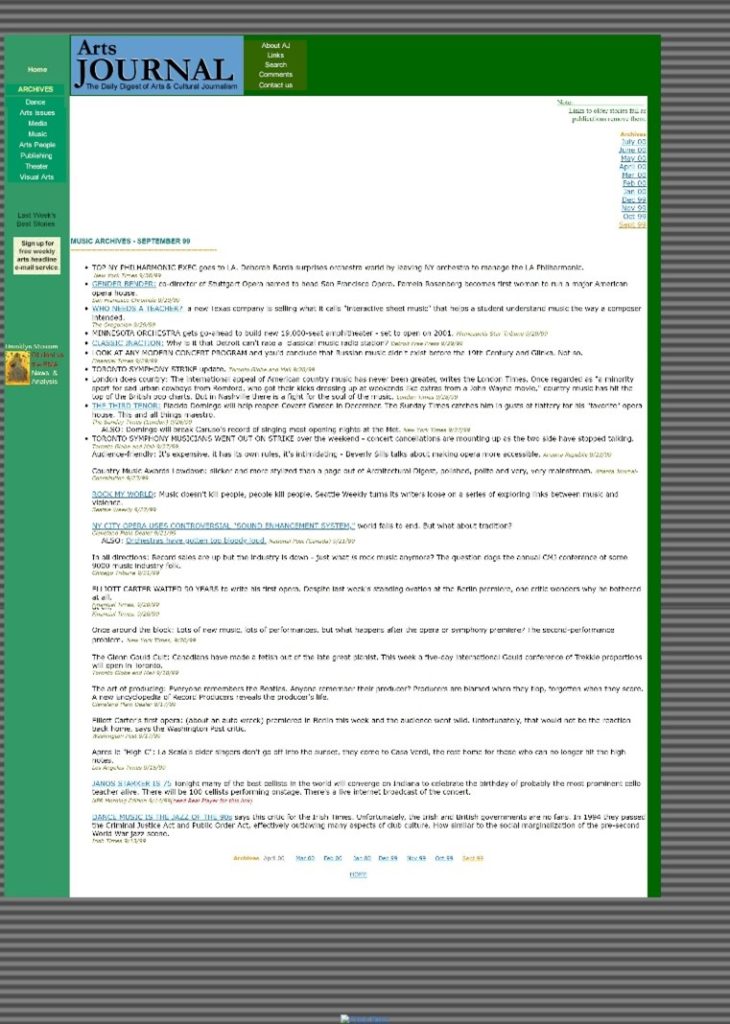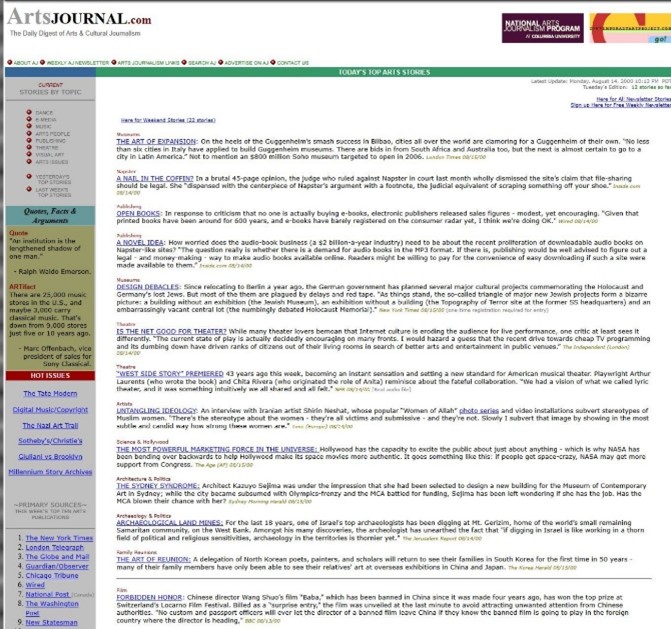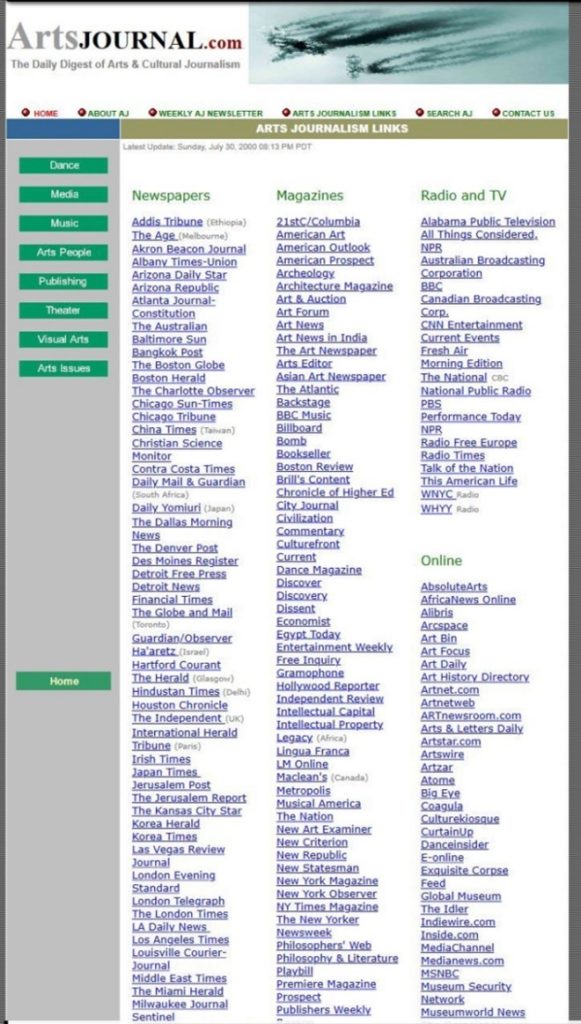This is the archives site for ArtsJournal.com. The site started September 13, 1999 and has aggregated 20-30 stories six days a week from across the arts world since then, without interruption. Over the years our archives were spread out across four platforms and formats, and this project has collected and standardized the databases into one searchable WordPress site here, thanks to the generous support of the Andrew W. Mellon Foundation.
There are more than 140,000 stories collected here spanning from the site’s first day on September 13, 1999 to December 31 2020. Artsjournal.com continues adding stories on the original site, and we’ll add to this Wayback site on a yearly basis.
The Archive

When the site began in 1999, there wasn’t a content management platform, so entries were coded and added manually into static html pages. Archives were created by hand. From December 2000 through November 2002 the site ran on a blogging platform called Web Crimson created by John Hiler and Xanga.com. In 2003 we migrated to Moveable Type, and finally in 2013 to WordPress, which runs the site today.
Some notes on using the archive
- You’ll notice that for much of 2001 and 2002, there appear to be far fewer entries. This is because each of those monthly entries contains stories for a category for an entire month.
- Stories are listed with their sources, dates they were originally published, the dates we aggregated them and their original URLs. In general, the older the story, the less likely the links are to work, since all of the sites we collected from have — like ArtsJournal — evolved to new platforms, and link structures weren’t preserved in many cases. Still, older stories whose links are broken may still be found based on our information about them.
- We’d like to report that these archives are complete. They are not. There are two months of dance stories missing from the early 2000s and one month of issues stories.
- Our ArtsJournal blogs are still found at their original URLs. We will be setting up an index of these, including a series of debate/discussion blogs we hosted.
Some Historical Context
September 13, 1999, at the height of the dotcom boom, ArtsJournal (https://www.artsjournal.com) launched as one of the first aggregator/curator sites on the internet, devoted to collecting significant stories about arts and culture from English-language press worldwide. Each day, editors scanned hundreds of newspapers and magazines for stories that dealt with how we interact with culture, posting 20-30 stories a day across all the arts, chosen from more than 200 sources and 1000 stories/day.
The site began without a business model and has remained viable over the years with a combination of ad and newsletter subscription revenue, grants from various foundations and for-hire customized projects. The project was the idea of Douglas McLennan, who, when the site launched was an arts critic for the Seattle Post-Intelligencer newspaper. Over the years several editors assisted on the site, including Sam Bergman, Jessica Werner, and Laura Collins-Hughes. For the past ten years, editors Suzi Steffen in Eugene, Oregon and Matthew Westphal in NYC have assisted in editing the site.
Never intended as purely a news service, the site over time chronicled changes in our cultural life, tracking issues and trends and how our relationship with culture was evolving. Beginning in 2002, ArtsJournal began hosting blogs by critics and journalists, eventually becoming home to some 60 bloggers – many of them prominent writers and critics. And the site was home to a series of weeklong online discussion/debates, inviting prominent critics and cultural figures to debate cultural issues of the day. Over the years the site became a daily touchstone for thousands of readers interested in following the arts, among them many leaders in the arts (current readership estimated to be holding steady at about 50,000-60,000 per day).
Along the way, the site collected stories unfolding in drip drip fashion of a remarkable transformational period in American culture. When ArtsJournal began in the last century, the cultural world was firmly anchored in mature business models and traditional institutional cultural delivery systems that had thrived since mid-century. No smart phones, no social media, no streaming. Globalism was a hot topic, the internet was relatively new, technology promised the democratization of everything, and mass culture was measured in TV audience and CD sales.

Twenty years on, the digital revolution has threatened the business models that underpin virtually every cultural enterprise, social media has transformed the ways we communicate, globalism has given way to nationalism, our institutions are under attack, audiences and platforms collect audience on a scale that dwarfs 20th Century notions of mass media, and tech utopianism has given way to darker visions. The digital revolution has also powered extraordinary access to information and institutions and people and changed how people interact with one another, with their communities and with their institutions.
To illustrate: in the first week of ArtsJournal, for example, we posted a story that reported that sales of CDs had reached their all-time high. This would turn out to be a high-water mark, as sales of physical media delivery of music collapsed from there, cannibalized first by Napster (which had recently launched) and later by commercial streaming.
Twenty years later our relationships with and expectations of culture across the arts has fundamentally changed. The ArtsJournal archives are a unique story-by-story history, compiled day-by day in real time over two decades of these issues and changes, as seen through a cultural lens.
ArtsJournal is distinct in its coverage because we don’t distinguish between non-profit culture and commercial culture in our coverage. There is also a significant vein of technology stories throughout as these deal with the evolution of thinking about gathering and building audience and communities through technologies. This throughline is perhaps the most significant thread through the era. The biggest story throughout the past 20 years has been the changes in how we communicate, find community and share culture. Though often portrayed as a tech story, it’s really a cultural one.
ArtsJournal has documented these changes across cultures through the daily stories we post. But the site’s operations have also evolved during this time. When the site launched, for example, nearly all of our sources were newspapers and traditional print magazines. There were only a handful of purely online publications. We drew on English-language publications from all over the world.
In the first decade of the 21st Century, half of all staff arts journalism jobs in the United States were eliminated. Until the early 2000’s it was pretty standard for most mid-size newspapers to have a roster of staff critics to cover movies, TV, theatre, visual and music. By 2010 it was the exception, and today public discourse about the arts in daily general journalism publications gets only a passing nod, and then usually only previews of important events and few reviews.

Interestingly, in the early years of ArtsJournal, it was often difficult to collect 20 daily stories of importance across all of our sources. Today, there is the opposite problem. The amount of good, incisive writing about the arts has grown enormously as online publications have stepped up, and the diversity of voices has exploded.
What has been sacrificed, though, is attention at the local level, and reporting about the arts, artists and institutions outside of most major metro newspapers is rare. Arts organizations which used to depend on “the press” to spread the word to sell tickets, largely moved to social media, where they can control the message and speak directly to their communities. This is also true in sports and entertainment, and while we’ve seen intensely motivated fan communities gather around arts, sports and entertainment, audiences have fragmented, and in recent years declined as we move to Second Generation social media.
Our archives detail how this happened across thousands of stories, from Napster to iTunes to Spotify et al. As this era transformed our relationships with arts and culture, the story of how that has unfolded has yet to be written. This is an era that has disrupted our cultural infrastructure, changed the ways we share culture, and impacted our ability to cultivate and deliver culture in communities. We have collected thick veins of stories that trace changes in this infrastructure – how technology has made some art forms better and more viable, (TV for example) and others more difficult (classical music, in part because of metadata and discoverability issues).
Additionally, as we shifted from traditional institution-based cultural infrastructure, the new (often digital) infrastructures that took hold across our culture disadvantaged many traditional art forms. Discoverability, for example, is increasingly driven by individualized algorithms that tend to push down certain types of culture in favor of quick, inflammatory hits. This hasn’t happened all at once – it’s been an evolution since the earliest days of social media.
You can explore all of it through this archive.
